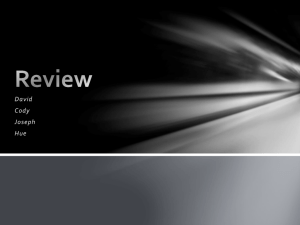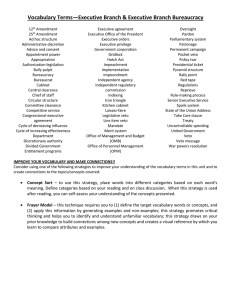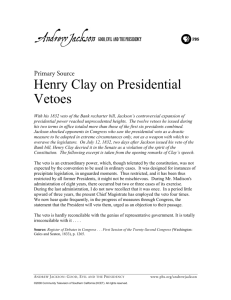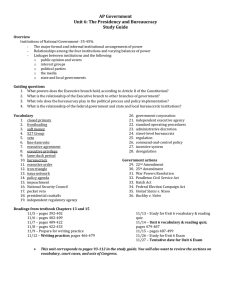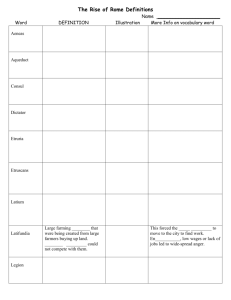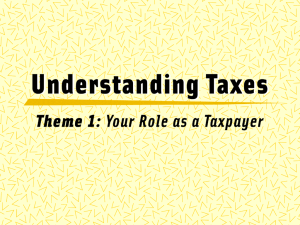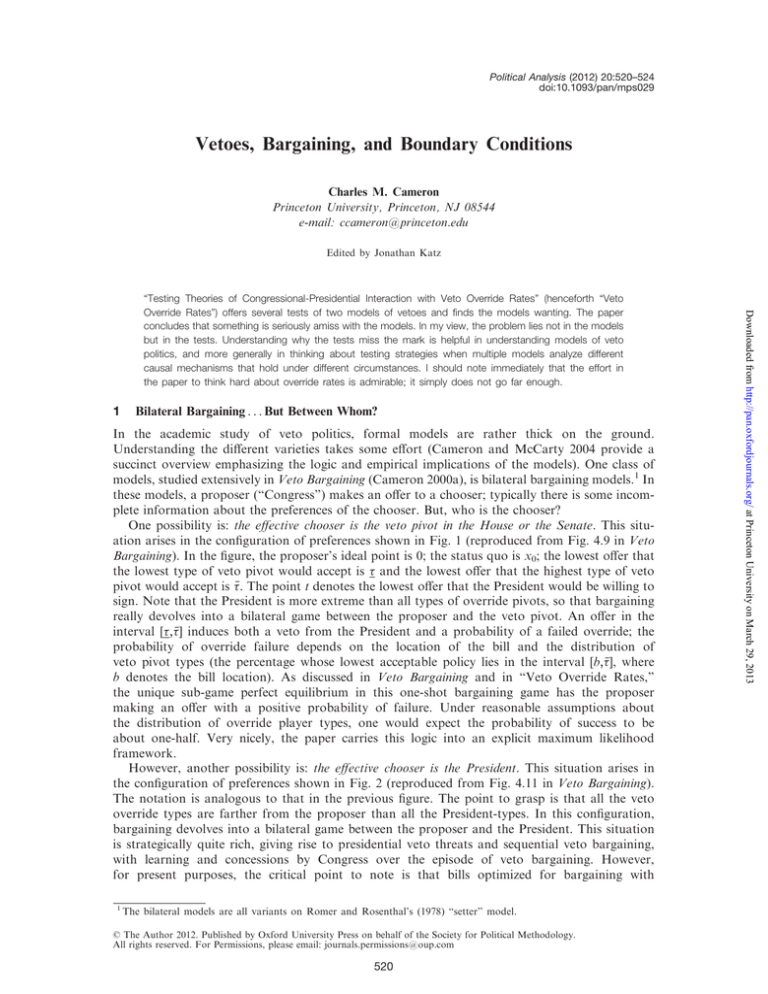
Political Analysis (2012) 20:520–524
doi:10.1093/pan/mps029
Vetoes, Bargaining, and Boundary Conditions
Charles M. Cameron
Princeton University, Princeton, NJ 08544
e-mail: ccameron@princeton.edu
Edited by Jonathan Katz
1
Bilateral Bargaining . . . But Between Whom?
In the academic study of veto politics, formal models are rather thick on the ground.
Understanding the different varieties takes some effort (Cameron and McCarty 2004 provide a
succinct overview emphasizing the logic and empirical implications of the models). One class of
models, studied extensively in Veto Bargaining (Cameron 2000a), is bilateral bargaining models.1 In
these models, a proposer (“Congress”) makes an offer to a chooser; typically there is some incomplete information about the preferences of the chooser. But, who is the chooser?
One possibility is: the effective chooser is the veto pivot in the House or the Senate. This situation arises in the configuration of preferences shown in Fig. 1 (reproduced from Fig. 4.9 in Veto
Bargaining). In the figure, the proposer’s ideal point is 0; the status quo is x0; the lowest offer that
the lowest type of veto pivot would accept is and the lowest offer that the highest type of veto
The point t denotes the lowest offer that the President would be willing to
pivot would accept is .
sign. Note that the President is more extreme than all types of override pivots, so that bargaining
really devolves into a bilateral game between the proposer and the veto pivot. An offer in the
interval ½, induces both a veto from the President and a probability of a failed override; the
probability of override failure depends on the location of the bill and the distribution of
veto pivot types (the percentage whose lowest acceptable policy lies in the interval ½b,, where
b denotes the bill location). As discussed in Veto Bargaining and in “Veto Override Rates,”
the unique sub-game perfect equilibrium in this one-shot bargaining game has the proposer
making an offer with a positive probability of failure. Under reasonable assumptions about
the distribution of override player types, one would expect the probability of success to be
about one-half. Very nicely, the paper carries this logic into an explicit maximum likelihood
framework.
However, another possibility is: the effective chooser is the President. This situation arises in
the configuration of preferences shown in Fig. 2 (reproduced from Fig. 4.11 in Veto Bargaining).
The notation is analogous to that in the previous figure. The point to grasp is that all the veto
override types are farther from the proposer than all the President-types. In this configuration,
bargaining devolves into a bilateral game between the proposer and the President. This situation
is strategically quite rich, giving rise to presidential veto threats and sequential veto bargaining,
with learning and concessions by Congress over the episode of veto bargaining. However,
for present purposes, the critical point to note is that bills optimized for bargaining with
1
The bilateral models are all variants on Romer and Rosenthal’s (1978) “setter” model.
ß The Author 2012. Published by Oxford University Press on behalf of the Society for Political Methodology.
All rights reserved. For Permissions, please email: journals.permissions@oup.com
520
Downloaded from http://pan.oxfordjournals.org/ at Princeton University on March 29, 2013
“Testing Theories of Congressional-Presidential Interaction with Veto Override Rates” (henceforth “Veto
Override Rates”) offers several tests of two models of vetoes and finds the models wanting. The paper
concludes that something is seriously amiss with the models. In my view, the problem lies not in the models
but in the tests. Understanding why the tests miss the mark is helpful in understanding models of veto
politics, and more generally in thinking about testing strategies when multiple models analyze different
causal mechanisms that hold under different circumstances. I should note immediately that the effort in
the paper to think hard about override rates is admirable; it simply does not go far enough.
Vetoes, Bargaining, and Boundary Conditions
0
τ
τ
t
521
x0
Fig. 1 Bargaining between congress and the veto pivot.
2
Bargaining Before An Audience . . . That Isn’t Listening?
A very different class of models concerns bargaining before an audience. In these models the
bilateral bargaining over policy is only part of the action; in addition, the bargaining is partly
political theatre designed to make an impression on an audience. This perspective on vetoes was
first advanced informally in important and innovative work by Gilmour (1995); it was formalized in
a neat game-theoretic model by Groseclose and McCarty (henceforth, GM).5
The Gilmour–Groseclose–McCarty version of audience bargaining is well-captured in the phrase
“blame-game.” Here, Congress constructs an offer which, if vetoed by the President, leads the
2
One could develop a maximum likelihood estimator of the probability of a veto for this configuration, using exactly the
methods shown in the paper.
The key conditions are > t and
t > : There are four possible configurations of this kind; the figure shows only one.
both a veto and a successful override are possible.
When the bill is in the interval minft,g, minft,g
4
In fact, if the “test” had succeeded it would have been an embarrassment for the sequential veto bargaining model and
(to a degree) the veto threat model, suggesting that the configurations to which they apply occur only rarely. This
finding would present an empirical conundrum, considering the frequency of veto threats and sequential veto bargaining. Fortunately the paper derived the opposite—and almost certainly correct—result.
5
As a side-note: this class of models is not analyzed in Veto Bargaining because the formalization of the audience
bargaining model was more-or-less contemporaneous with the composition of the book. If I were rewriting the book
today, I would afford close attention to audience bargaining models.
3
Downloaded from http://pan.oxfordjournals.org/ at Princeton University on March 29, 2013
the President—that is, in the interval ½t,t—will hopelessly fail in an override attempt. Most
likely, no such attempt will even be made. The paper’s Propositions 1 and 2 both fail in this
configuration.2
There is a third case in which the sets of presidential types and veto pivot types over-lap; an
example is shown in Fig. 3.3 In this situation, a bill may be geared for bargaining with the President,
but in the event of a veto an override attempt may not be an utterly forlorn hope. An override
attempt may follow, but the probability of success may be far below 50%.
The empirical test in the paper makes no effort to distinguish the configurations in Figs. 1, 2, and
3 from one another. In fact, “Veto Override Rates” simply ignores the Figs. 2 and 3 configurations.
The data are almost certainly generated from a mix of the configurations, perhaps even within a
single Congress. A reasonable ex ante prediction, then, is that aggregate override probabilities will
be considerably lower than predicted in the Fig. 1 configuration. And indeed this is what the paper
finds.4
Carrying the simple override model for Fig. 1 configurations into a neat maximum likelihood
framework is a worthwhile accomplishment. However, in that spirit the same needs to be done for
the configurations in Figs. 2 and 3, and then all three embedded in a switching regimes framework,
simultaneously estimating the probability of each configuration and the estimated override rate.
This would be a substantial feat; I conjecture that if carried out, the override data would broadly
support the bilateral bargaining models.
I should note in passing, however, that Veto Bargaining uncovered a strong empirical regularity
in override attempts: they are very rare for unimportant legislation and very frequent for the
most important legislation (see Fig. 2.4: 54). (Success conditional on an override attempt was
about 45% across all types of vetoed bills.) This striking pattern in override attempts suggests
a model in which securing costly floor time for an override attempt is difficult and related to the
bill’s importance. A model that included this feature and then generated interesting comparative
statics on override attempts, might well afford new insights on veto override rates.
522
Charles M. Cameron
0
t
τ
t
x0
Fig. 2 Bargaining between Congress and the President.
0
t
τ
t
τ
x0
audience to infer the President is more ideologically extreme than it had supposed. To the best of
my knowledge, little attention has been given to other possible versions of audience bargaining. For
example, Congress offers bills that put it in a favorable light given a likely veto (fame-game vetoes);
or the President vetoes bills in order to draw public attention to bills that put Congress in an
unfavorable light (shame-game vetoes). Also, little attention has been paid to “narrow casting”
models in which the target audience is a particular highly attentive group (farmers, women’s
groups, Tea Party members) rather than the inattentive general public.
Be that as it may, “Veto Override Rates” tries to draw out the implications of the GM blame
game veto model for overrides. To do so, the paper adds a veto override player to the GM model,
as in the bilateral bargaining models discussed earlier. However, the proposed model assumes that
the preferences of this player are completely known. This seemingly innocuous assumption has
powerful implications. In particular, if a veto of a bill will be over-ridden (which is always clear,
given the informational assumption), then the bill’s passage is assured. Hence, if the president pays
a popularity cost from a veto, he will never veto such a bill since he gains nothing in a policy sense
but only loses popularity. (This logic is spelled out in Proposition 3 in the paper.) Thus, the model
predicts that no vetoes will ever be over-ridden. The override data immediately reject this version of
the GM model without recourse to any formal statistical tests.
A more reasonable modeling choice would be to incorporate some incomplete information about
the location of the veto pivot’s ideal point—exactly as in the override model discussed earlier.
However, this assumption also has strong implications. First, if the configuration is as shown in
Fig. 1, the veto cannot provide new information about the President’s policy preferences. So, no
blame game and no movement in audience beliefs about the President. (This point is made in the
paper.) However, if the preference configuration is as shown in Fig. 2, the game is exactly as
analyzed in Groseclose and McCarty (2001). Vetoes can provide new information about the
President’s preferences; and, vetoes will not be over-ridden. Critically, if the preference configuration is as shown in Fig. 3, then a well-placed bill can provide new information about the
President’s preferences. In addition—because both Congress and President face a lottery in the
override attempt—overrides may be attempted and may succeed. So, vetoes may or may not
provide new information to voters, and some of those that do may lead to successful overrides.
In short, both non-over-ridden vetoes and over-ridden vetoes may provide the audience with new
information. Hence, the test proposed in “Veto Override Rates” is seriously weakened. The point is
acknowledged in the paper’s footnote 6, but the bite of the problem is unduly minimized. An
arguably cleaner approach would be to separate out the Fig. 1-configuration vetoes from the
others, and then look for opinion movement only in the Figs. 2- and 3-configuration vetoes,
with no movement in the Fig. 1-configuration vetoes. To the best of my knowledge, this is
a novel idea that follows from adding a veto override player to the GM model. This test is not
undertaken in the paper, however.
Downloaded from http://pan.oxfordjournals.org/ at Princeton University on March 29, 2013
Fig. 3 Bargaining between Congress and the President, possibly followed by an override lottery.
Vetoes, Bargaining, and Boundary Conditions
523
3
The Importance of Boundary Conditions
Veto politics is unusual in Political Science, and nearly unique in the study of presidential politics,
because there are multiple formal models addressing the same phenomenon. (The modal number of
formal models of most political phenomena is zero.) Critically, different veto models emphasize
different causal mechanisms that operate under different circumstances.
This raises the question: When we have multiple models of the same phenomenon positing
different causal mechanisms that hold under different conditions, how should we evaluate the
models? For example, the bilateral bargaining models associated with Figs. 1, 2, and 3 make
quite different predictions about veto override rates: about 50% (more or less), 0%, and something
between 0% and 50%, respectively. A reasonable approach might try to sort vetoes according to
the configuration that probably generated them, and compare the actual override rates in each
“bin” with the predicted over-rate rate, making some adjustment for measurement error. One might
also compare the rates across the bins, and see if the patterns conform to expectations. But simply
ignoring two of the three configurations—when the models themselves say they are important—is not
apt to be illuminating.
Suppose the boundary conditions are less explicit. For example, the GM blame game model
simply assumes that the audience is actually attentive to the veto bargaining; the model then
explores some implications given audience attention. A fair test of the model should (it seems to
me) try to employ data that conforms to this boundary condition, even though it is implicit. One
could also explore the scope of the boundary condition itself: how often is the public actually
attentive to veto bargaining? But “testing” the model using a great deal of data that falls well
outside the model’s scope isn’t very illuminating.
In short, when multiple models analyze different causal mechanisms that apply under different
circumstances, close attention in empirical work to the models’ boundary conditions is essential.6
The point is fairly obvious but bears repeating.
To put in bluntly, the empirical tests in “Veto Override Rates” are not attentive to the boundary
conditions in the veto models. As a result, they are not very illuminating. In this sense, the paper
falls short.
4
Conclusion
As the reader will have inferred, in my opinion “Veto Override Rates” raises no genuine issues
about the empirical reach of the bilateral bargaining or audience bargaining models of vetoes. But
let me emphasize again the paper’s notable virtues, particularly the maximum likelihood implementation of the veto pivot model. This is nicely done. Also, as I indicated, incorporating veto
overrides into the canonical audience bargaining model is a worthwhile idea that could lead, with
6
This does not mean that data cannot, and will not, reject a given model: If the boundary conditions say a model should
apply, and the data then reject the model, game over—and back to the drawing board.
Downloaded from http://pan.oxfordjournals.org/ at Princeton University on March 29, 2013
Unfortunately, there is another serious issue with the paper’s empirics on audience vetoes:
audience vetoes require an audience. Most vetoes are quite obscure events. Indeed, given what we
know about political information levels in the electorate (Delli Carpini and Keeter 1996), it may be
amazing that even the most spectacular vetoes, like Truman’s of the Taft-Hartley Act, could
seriously impinge on the consciousness of many voters and move their beliefs about the
President. For exactly this reason, Groseclose and McCarty’s original test focused exclusively on
vetoes of the most prominent legislation. The test in “Veto Override Rates” does no such thing,
citing data limitations (footnote 12). But it would be easy to focus on, say, vetoes covered on the
front page of the New York Times or Wall Street Journal. Testing a model of audience vetoes using
vetoes that the audience could scarcely know about, is a strange choice.
My own belief is that audience vetoes are rather special events—but they do occur. (In Cameron
2000b, I tried to identify the clearest examples of audience vetoes in the post-War period). The
empirical evidence presented in “Veto Override Rates” does not alter my priors about audience
vetoes at all.
524
Charles M. Cameron
some simple modifications, to new and potentially interesting empirical work. More generally, the
paper may lead a reader to think harder about veto override rates. But close attention to boundary
conditions throughout is essential.
In closing, I would note a more subtle point. The paper suggests that the veto affords the
President a potent entrée into the legislative process. Of course this is true! But most scholars of
the presidency would look to other sources of influence in the legislative arena as well. The agenda
setting power of the President and his ability to use the resources of the executive branch to shape
the content of legislation are probably more important avenues for presidential power in the
legislative arena than the veto (Beckmann 2010; Cohen 2012). Yet, in terms of formal theory,
presidential proposal power and drafting power are (to use Arnold’s phrase) relatively “under-tilled
fields” rather than “over-tilled” ones (Larocca 2006; Cameron and Park 2007 provide partial
exceptions). Scholarly rates of return from working in under-tilled fields can often be higher
than marginal advances in relatively over-tilled ones.
Beckmann, Mathew. 2010. Pushing the agenda: Presidential leadership in U.S. lawmaking. New York: Cambridge
University Press.
Cameron, Charles. 2000a. Veto bargaining: Presidents and the politics of negative power. New York: Cambridge University
Press.
———. 2000b. Presidential reputation and bargaining. In Presidential power: Forging the Presidency for the 21st century,
eds. Larry Jacobs, Martha Kumar, and Robert Y. Shapiro, 47–77. New York: Columbia University Press.
Cameron, Charles, and Nolan McCarty. 2004. Models of vetoes and veto bargaining. Annual Review of Political Science
7:407–35.
Cameron, Charles, and Jee-Kwang Park. 2007. A primer on the President’s legislative program. In Presidential leadership:
The vortex of power, eds. B. Rockman, and R. Waterman. New York: Oxford University Press.
Cohen, Jeffrey. 2012. The President’s legislative policy agenda 1789–2002. New York: Cambridge University Press.
Delli Carpini, Michael, and Scott Keeter. 1996. What Americans know about politics and why it matters. New Haven, CT:
Yale University Press.
Gilmour, John. 1995. Strategic disagreement: Stalemate in American politics. Pittsburgh, PA: University of Pittsburgh
Press.
Groseclose, Tim, and Nolan McCarty. 2001. The politics of blame: Bargaining before an audience. American Journal of
Political Science 45:100–19.
Larocca, Roger. 2006. The Presidential agenda: Sources of executive influence in congress. Columbus: Ohio State
University Press.
Romer, Tom, and Howard Rosenthal. 1978. Political resource allocation, controlled agendas, and the status quo. Public
Choice 33:27–44.
Downloaded from http://pan.oxfordjournals.org/ at Princeton University on March 29, 2013
References

